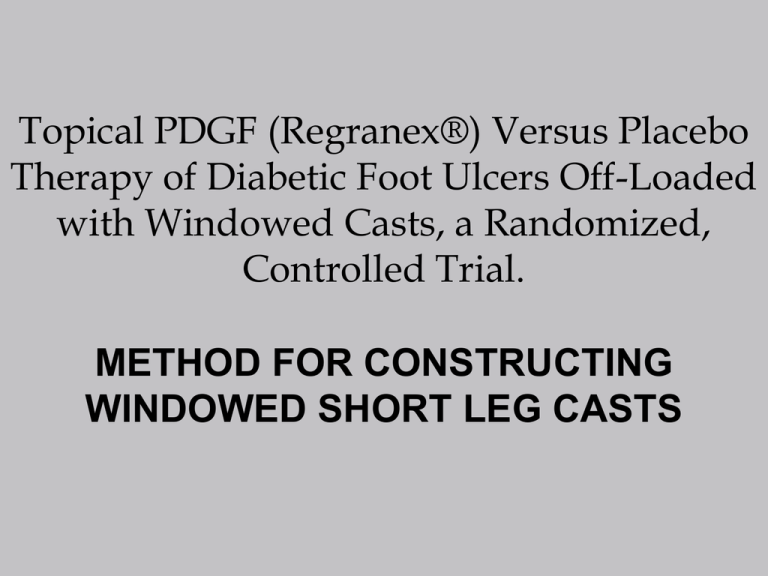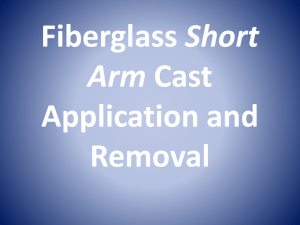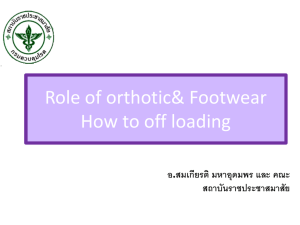Method of Window Casting
advertisement

Topical PDGF (Regranex®) Versus Placebo Therapy of Diabetic Foot Ulcers Off-Loaded with Windowed Casts, a Randomized, Controlled Trial. METHOD FOR CONSTRUCTING WINDOWED SHORT LEG CASTS WINDOW CASTING The basic design for casts employed in this study was based on the standard padded short leg walking cast. Our windowed casts had five layers [see next slide] starting with the skin: 1] a thick hydrocolloid protective layer applied directly to the skin around the wound (Duoderm CGF® - Convatec); 2] a cotton tubular roll gauze (Stockinette® - Alba Health); 3] water resistant foam padding (1/8” Delta Terry-Net™ Adhesive Terry Cloth / Foam Padding, Charlotte, NC); 4] cotton roll cast padding (Webril® -Kendall); 5] 3M™ Scotchcast Plus -4” fiberglass. In most cases a toe plate type cast was employed allowing toes more freedom of motion and exposure, but in some instances the forefoot was sealed completely within the cast. In a few instances, for example with Charcot deformity or transmetatarsal amputation, rubber plantar bars were fixed to the bottom of the cast, but in most cases only a standard cast shoe was dispensed to protect the bottom of the cast. WINDOWED CAST COMPONENTS TELFA WEBRIL FIBERGLASS CAST PLUG MOIST GAUZE STOCKINETTE DUODERM WOUND SKIN QUICKSTICK PADDING Side View of Cast Nail and padding For routine application the following steps were followed: 1] Clean the skin to be incorporated in the cast with warm water, dry the skin, and apply petrolatum from knee to ankle. 2] Apply Duoderm CGF® starting close to the wound perimeter and extending approximately 1.5” away from the wound. The area of the wound is exposed via a cut-out in the Douderm CGF®. This step is aimed at protecting the surrounding skin from moisture maceration. In wounds with excessive drainage, application of the Duoderm CGF® several inches away from the wound may be necessary to sufficiently protect a larger area of skin. 3] Use 3” or 4” Stockinette® to cover the foot, ankle, and leg with 6-8 inches additional on the distal end. Use extra Stockinette® proximally to allow roll-back of Stockinette® at this end. Accommodate ankle dorsiflexion with a transverse cut from malleolus to malleolus andoverlapping of the cut edges. Determine the exact location of the wound under the Stockinette®. 4] Place the foam padding over boney prominences including but not limited to the heel, the malleoli, and the anterior aspect of the tibia. This padding protects the skin from shearing and cast burns over boney prominences. 5]Cut a square piece of foam padding approximately 0.5 x 0.5 inches larger than the wound. Make a hole in the Stockinette® slightly larger than the wound and place directly over the center of the wound and attach it to the Duoderm® with the adhesive backing, moving the Stockinette® away. This step completes a picture frame centered around the wound comprising an inner layer of Duoderm CGF® and an outer layer of foam padding. 6] A pre-made square of padded foam with a sterilized 1” large head anodized roofing nail sticking up out of the padded foam is placed in the center of the wound with the nail spike pointed perpendicular to the wound surface. The nail spike will serve later as a marker buoy to guide cutting of the fiberglass plug. This step is employed when necessary for small wounds to accurate determine where to cut out the window (see step 13). 7] Apply three layers of Webril® padding extending from the heel to the dorsum of the foot, starting a the distal end, wrapping the foot and ankle. Make sure the nail spike is exposed outside the Webril®. Apply an additional three layers of Webril® from the dorsum of the foot to the proximal end of the Stockinette ® . Continue to wrap the leg to create generous padding using 50% overlap of the Webril® 8]. Moisten and apply the first roll of fiberglass starting on the lateral aspect of the foot. Apply two layers around the medial and lateral aspects. Wrap the dorsum of the foot and ankle. Apply the second roll of fiberglass starting at the distal end of the cast, wrapping the foot again and advancing to the intended proximal margin at the middle of the leg. 9] Position the ankle and foot in the desired position (usually neutral) by molding the plantar surface of the foot and all other landmarks of the ankle and leg. Start the third roll of fiberglass by fan folding four to five layers to create a reinforcing plantar fiberglass splint from heel to toe. Secure the fiberglass splint with the remainder of the third roll starting at the heel, wrapping the fiberglass in a spiral fashion all the way to the proximal margin of the cast. 10] Recheck the molds and make adjustments as needed. Check the molding of the leg and fold excess Stockinette ® and Webril® proximally and distally (if a toe plate type cast is constructed) over the fiberglass. 11] Take care to keep the marker nail spike exposed outside the Webril® and fiberglass during the steps 7-10. 12] Trim the fiberglass and Webril® toe plate area so that it is ½ to ¾’’ longer than the hallux., and trim the distal end to close to the 5th toe. Fashion an even line to maintain a smooth and well shaped finish cut. Secure the folded edges of Webril® and Stockinette® with tape to the fiberglass. Fold the proximal end of the cast down to make a soft circumferential dege. Apply a final layer of fiberglass to complete the cast. 13] Use a Sharpie® pen to mark the cast material for removal centered around the protruding nail spike. Cut out a squared window (cast plug) with a cast saw. Carefully pull on the nail to remove the cast plug. Remove the nail from the cast plug .) Remove or trim excess any excess Webril ® to expose the wound. It is important that when the cast plug is reinserted after dressing the wound that it not protrude above the level of the cast, particularly if the wound is over a weight bearing surface, as this will counteract off-loading . When plantar bars are employed a cast plug is not necessary, and the window may be sealed with tape between dressing changes. 14. Apply study medication and dress the wound with saline moistened 2x2” or 4x4” gauze (depending on wound size) and then a piece of Telfa®. The surface of the dressing should be flush with the surface of the Webril® layer of the cast. Place the cast plug back into the window and secure with tape. 15. Fit the patient with an appropriate cast shoe. Stockinette and Foam padding applied All Webriil applied Picture framing wound before Webril® First layer of fiberglass Applying Webril® Molding plantar aspect of fiberglass Plantar and medial-layer fiberglass reinforcement applied (arrows) for toe plate Cutting out the toe plate Cutting out the toe plate Finished short leg cast With toe plate Heel cut out for window over ulcer Before treatment In windowed cast Healed In windowed cast Before In windowed cast Healed During treatment Initial wound Healed at week 5 Before






